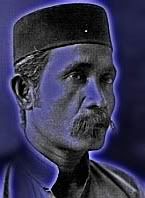Makang Belang Jjalang* No. 1
If a trip is fuelled through the stomach, I have to thank many people. My cousin Azmi and his wife Na in Kuala Terengganu, and all their 3 wonderful children (Hafiz, Farhan & Aisyah) took us to feasts and snacks galore. In the mornings there was nasi dagang, and roti kaya with old-fashioned tèh susu, and lunches were an array of things in many places: nasi kerabu here and ikang singgang and belacang pounded with buöh kerining there, and then nasi benör at a town centre restaurant, and fine dining at the delightfully named De luxe Paradise later. In the afternoon Mi would say, “Let's go for some ikang celok tepong somewhere by the shore," and in spite of our protests, he took us there, and we did not regret it even a little. I made friends with many cats there, all fattened by eating ppala ikang, and Kak Teh couldn't take her eyes away from the shore. As a footnote I must add my thanks here (for the trip to the De Luxe Paradise) to Abang Lèh and cousin Yöh. I am delighted to add here too Abang Lèh's confession that he is actually the cousin of our famous teksi man Cik Kalèh (see GUiT), and of course I couldn't believe my ears. Thanks too to cousin Dah (see, 'Fish on a Bicycle', GUiT, p. 81) and Abang Muin for the sumptuous family reunion at their hacienda.
We were regalled with beluda (see, 'Beluda Hands, Singing Head', GUiT, p.75) courtesy of the wonderful Cik Gu Mat of the Persatuan Sejarah Terengganu. It was he who took us on the Beluda Trail that you probably saw on RTM1's Galeri Perdana, and we were fed beluda made by the talented Kak Pöh who also showed how beluda was made for RTM1's 'Galeri Perdana' and for Astro TV who were following yours truly. Cik Gu was (and still is) a wonderful man, he pored through GUiT and took note of the comestibles, and then he popped up at my public appearances in Kuala Terengganu and proferred me rokok arab and apék-apék and roti paung packed neatly in tupperware. Overwhelming kindness is hard to forget, and hard to get over, and I thank you Cik Gu.
I'd also like to thank Toh Puan Rosita, a fine lady of Terengganu, whose dining table heaved with many cakes of old. She brought back many tasteful memories, and she brought some delightful company too, my old classmates from Sultan Sulaiman Secondary School, and my class teacher from standard 4, Mrs Yeoh (wife of the eminent artist Mr Yeoh Jin Leng). In Kuala Terengganu my former classmate Toh Swee Choo (I hadn't seen her since the '60s) organised a reunion at another classmate's house (thank you Datin “Jöh” Khadijah) where I met Chua Chee Peng, Tan Yam Poy, Wan Fatimah Abdullah, Yusof Abdul Rahman, to name but a few — friends I hadn't seen since the day I left SSSS and Kuala Trengganu. Another person from my past, Dato Wee Cheng Huat, was also there. As Mr Wee he was my Form Teacher for 2 years at secondary school.
And then, another day at the Restoran Kuah Singgang (where I had the belacang with kerining), I was reunited with my SSS classmates Muhammad Embong (the boy from Lorong Jjamil, see 'To Each A Quarter', p. 145, GUiT), Omar Abd Rahman (who left SSSS to come back as its headmaster, and then later, as Trengganu's CEO), and Hashim Sulong, a friend from Kampong Kolam a stone's throw from the Istana (see GUiT, everywhere) who was also himself a talented artist at school. On the same day I heard on the phone a voice from the trishaw of many, many years ago, Lim Chee Hian (who, as C.H.Lim in GUiT, p. 166 supra, travelled with me and H.C.Tay to school, in Pök Mat's teksi). Another day I nearly had a heart attack when my cousin Mi said “Your old school teacher has just phoned, and he's coming to see you now.” It turned out to be my old Maths teacher, Mr Soh Kim Yew, who came all the way from Ipoh. I could still hear his voice, “I'm going to see your father!” for my unsatisfactory homework. When he arrived we hugged each other, and then he said it again, but in impeccable Trengganuspeak, “Aku nök gi jjupe pök mung!”
I trembled with laughter.
I'd like to keep KL for another time, but as it's food I'm talking about, I must thank my wife's people in Bangi (Lilah & Wan, Ajie & Nisah, Prof & Kak Chik, and Mak of course) for food aplenty — always — on their tables, and for our many trips to stalls, cafes and food centres; and also to my sister Wan Asma for being unstinting at the dining table, and for troubling to make me beleda and puding kkuöh as Cik used to make it, with agar-agar and with its milky sauce, and for the stirring hasidöh and the jjala mas that she packed for me to take back to Londra. To my nieces Kak Chik and Kak Long, and Cik Mun and my nephew Cik Mang, thanks for the many trips to Nasi Dagang Ulik Mayang, and to the Mamaks, and to various other food centres.
And thanks too to my brother Mil (Wan Abdul Rahim Kamil, GUiT, p.11) and wife Norlia for the food and the broadband whenever I called.
----------------------
*Eating on the trot.
Labels: beluda, Cik Gu Mat, Cik Kaleh, Hashim Sulong, hasidoh, jjala mas, Lim Chee Hian, Muhammad Embong, Omar Abd Rahman, Soh Kim Yew, Toh Puan Rosita, Toh Swee Choo, Wan Abd Rahim Kamil, Wee Cheng Huat

